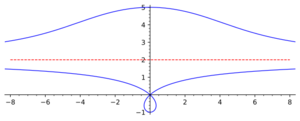Difference between revisions of "Nicomedes conchoid"
(Importing text file) |
|||
| (3 intermediate revisions by 3 users not shown) | |||
| Line 1: | Line 1: | ||
| + | {{TEX|done}} | ||
A plane [[Algebraic curve|algebraic curve]] of order 4 whose equation in Cartesian rectangular coordinates has the form | A plane [[Algebraic curve|algebraic curve]] of order 4 whose equation in Cartesian rectangular coordinates has the form | ||
| − | + | $$(x^2+y^2)(x-a)^2-l^2x^2=0;$$ | |
and in polar coordinates | and in polar coordinates | ||
| − | + | $$\rho=\frac{a}{\sin\psi}\pm l.$$ | |
| − | + | [[File:Nicomedes conchoid.svg|center|300px|Nicomedes conchoid with parameters (a,l)=(2,3)]] | |
| − | + | Outer branch (see Fig.). Asymptote $x=a$. Two points of inflection, $B$ and $C$. | |
| − | + | Inner branch. Asymptote $x=a$. The coordinate origin is a double point whose character depends on the values of $a$ and $l$. For $l<a$ it is an isolated point and, in addition, the curve has two points of inflection, $E$ and $F$; for $l>a$ it is a [[Node|node]]; for $l=a$ it is a [[Cusp(2)|cusp]]. The curve is a [[Conchoid|conchoid]] of the straight line $x=a$. | |
| − | |||
| − | Inner branch. Asymptote | ||
The curve is named after Nicomedes (3rd century B.C.), who used it to solve the problem of trisecting an angle. | The curve is named after Nicomedes (3rd century B.C.), who used it to solve the problem of trisecting an angle. | ||
====References==== | ====References==== | ||
| − | <table><TR><TD valign="top">[1]</TD> <TD valign="top"> A.A. Savelov, "Planar curves" , Moscow (1960) (In Russian)</TD></TR></table> | + | <table> |
| − | + | <TR><TD valign="top">[1]</TD> <TD valign="top"> A.A. Savelov, "Planar curves" , Moscow (1960) (In Russian)</TD></TR> | |
| − | + | <TR><TD valign="top">[a1]</TD> <TD valign="top"> J.D. Lawrence, "A catalog of special plane curves" , Dover, reprint (1972)</TD></TR> | |
| − | + | </table> | |
| − | |||
| − | + | [[Category:Geometry]] | |
| − | |||
| − | |||
Latest revision as of 15:40, 17 March 2023
A plane algebraic curve of order 4 whose equation in Cartesian rectangular coordinates has the form
$$(x^2+y^2)(x-a)^2-l^2x^2=0;$$
and in polar coordinates
$$\rho=\frac{a}{\sin\psi}\pm l.$$
Outer branch (see Fig.). Asymptote $x=a$. Two points of inflection, $B$ and $C$.
Inner branch. Asymptote $x=a$. The coordinate origin is a double point whose character depends on the values of $a$ and $l$. For $l<a$ it is an isolated point and, in addition, the curve has two points of inflection, $E$ and $F$; for $l>a$ it is a node; for $l=a$ it is a cusp. The curve is a conchoid of the straight line $x=a$.
The curve is named after Nicomedes (3rd century B.C.), who used it to solve the problem of trisecting an angle.
References
| [1] | A.A. Savelov, "Planar curves" , Moscow (1960) (In Russian) |
| [a1] | J.D. Lawrence, "A catalog of special plane curves" , Dover, reprint (1972) |
Nicomedes conchoid. Encyclopedia of Mathematics. URL: http://encyclopediaofmath.org/index.php?title=Nicomedes_conchoid&oldid=13493
